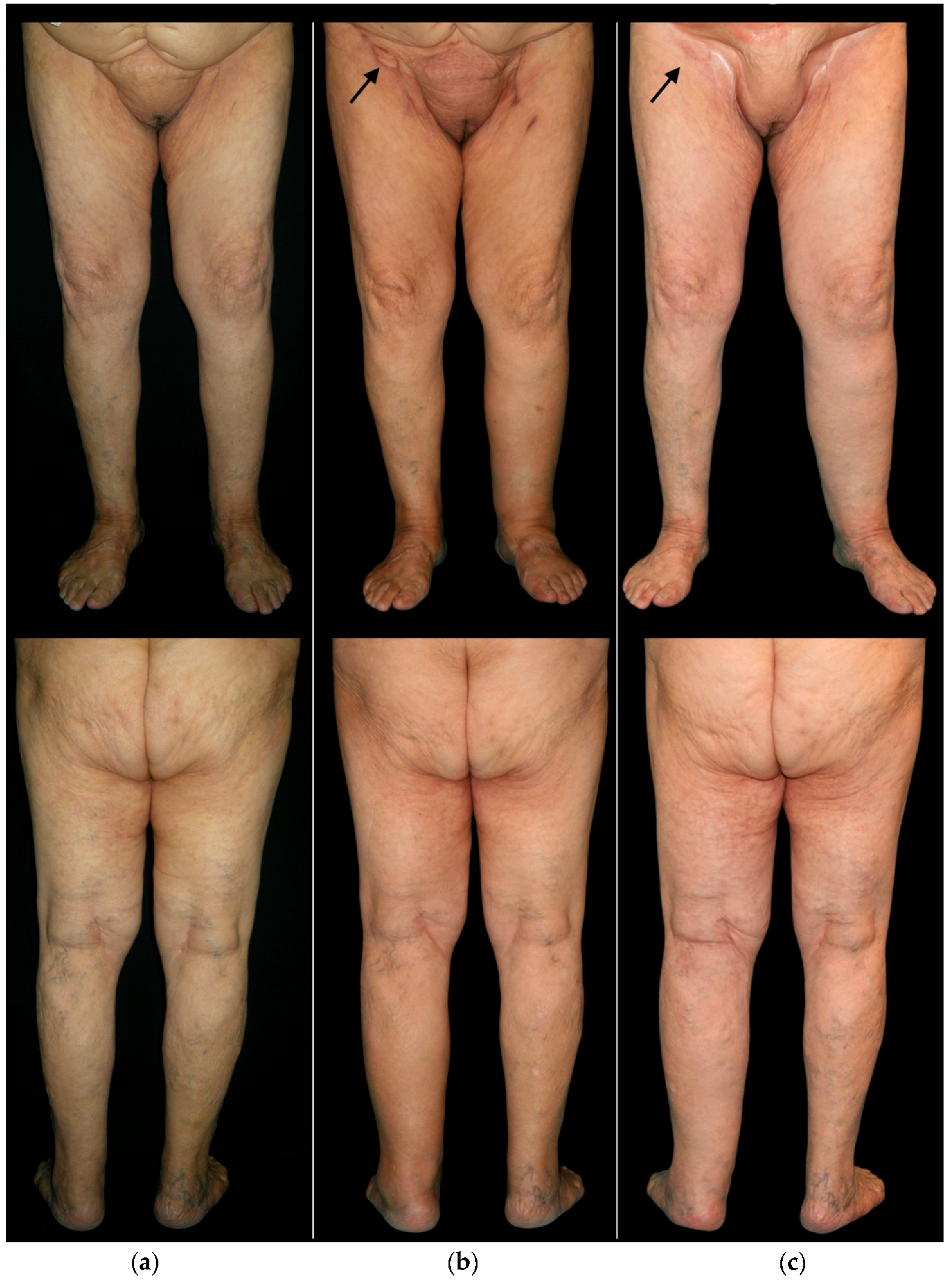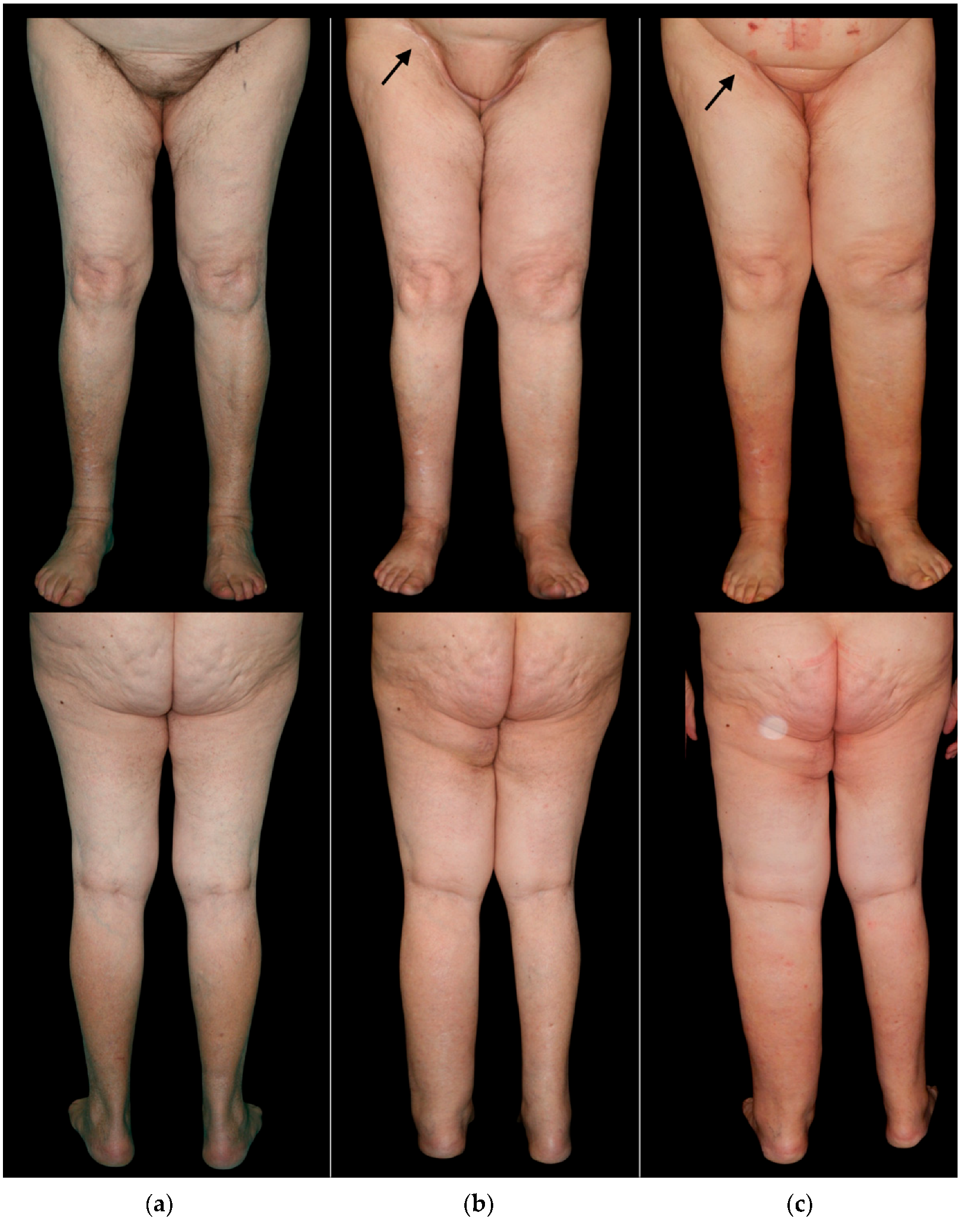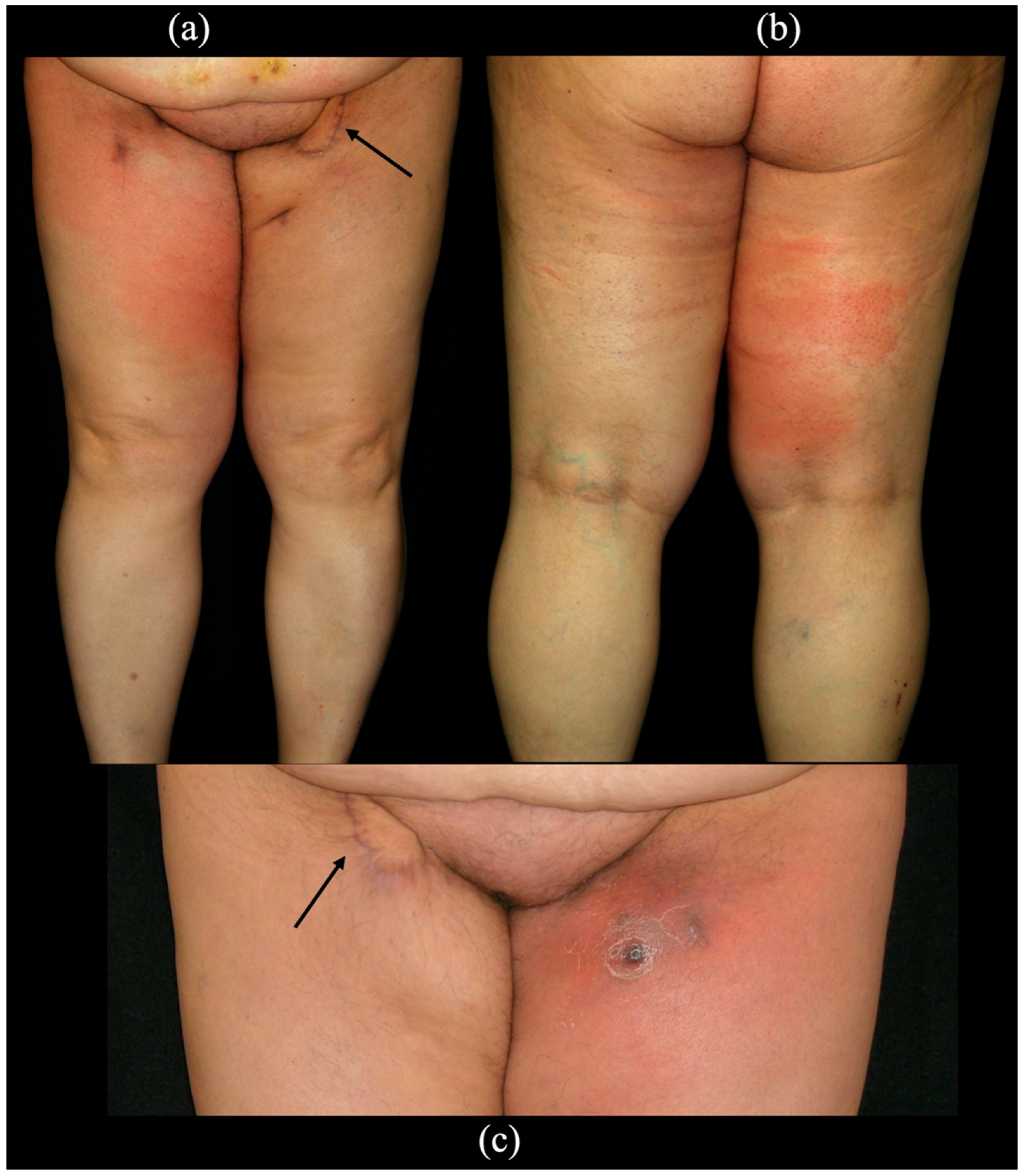Lymphatic Function of the Lower Limb after Groin Dissection for Vulvar Cancer and Reconstruction with Lymphatic SCIP Flap
Abstract
:Simple Summary
Abstract
1. Introduction
2. Materials and Methods
Statistical Analysis
3. Results
4. Discussion
5. Conclusions
Author Contributions
Funding
Institutional Review Board Statement
Informed Consent Statement
Data Availability Statement
Conflicts of Interest
References
- Stehman, F.B.; Bundy, B.N.; Dvoretsky, P.M.; Creasman, W.T. Early stage I carcinoma of the vulva treated with ipsilateral superficial inguinal lymphadenectomy and modified radical hemivulvectomy: A prospective study of the Gynecologic Oncology Group. Obstet. Gynecol. 1992, 79, 490–497. [Google Scholar]
- Burke, T.W.; Levenback, C.; Coleman, R.L.; Morris, M.; Silva, E.G.; Gershenson, D.M. Surgical therapy of T1 and T2 vulvar carcinoma: Further experience with radical wide excision and selective inguinal lymphadenectomy. Gynecol. Oncol. 1995, 57, 215–220. [Google Scholar] [CrossRef] [PubMed]
- Hinten, F.; Van den Einden, L.C.G.; Hendriks, J.C.M.; Van der Zee, A.G.J.; Bulten, J.; Massuger, L.F.A.G.; Van de Nieuwenhof, H.P.; De Hullu, J.A. Risk factors for short- and long-term complications after groin surgery in vulvar cancer. Br. J. Cancer 2011, 105, 1279–1287. [Google Scholar] [CrossRef] [PubMed]
- Manci, N.; Marchetti, C.; Esposito, F.; De Falco, C.; Bellati, F.; Giorgini, M.; Angioli, R.; Panici, P.B. Inguinofemoral lymphadenectomy: Randomized trial comparing inguinal skin access above or below the inguinal ligament. Ann. Surg. Oncol. 2009, 16, 721–728. [Google Scholar] [CrossRef] [PubMed]
- Madhuri, T.K.; Tailor, A.; Butler-Manuel, S. Use of neutral plasma coagulation in groin node dissection for vulvar malignancy: A novel technique. Cancer Manag. Res. 2011, 3, 253–255. [Google Scholar] [CrossRef] [PubMed]
- Judson, P.L.; Jonson, A.L.; Paley, P.J.; Bliss, R.L.; Murray, K.P.; Downs, L.S., Jr.; Boente, M.P.; Argenta, P.A.; Carson, L.F. A prospective, randomized study analyzing sartorius transposition following inguinal-femoral lymphadenectomy. Gynecol. Oncol. 2004, 95, 226–230. [Google Scholar] [CrossRef] [PubMed]
- Gupta, M.K.; Patel, A.P.; Master, V.A. Technical considerations to minimize complications of inguinal lymph node dissection. Transl. Androl. Urol. 2017, 6, 820–825. [Google Scholar] [CrossRef] [Green Version]
- Yao, K.; Zou, Z.J.; Li, Z.S.; Zhou, F.J.; Qin, Z.K.; Liu, Z.W.; Li, Y.H.; Han, H. Fascia lata preservation during inguinal lymphadenectomy for penile cancer: Rationale and outcome. Urology 2013, 82, 642–647. [Google Scholar] [CrossRef]
- Kumar, V.; Sethia, K.K. Prospective study comparing video-endoscopic radical inguinal lymph node dissection [VEILND] with open radical ILND [OILND] for penile cancer over an 8-year period. BJU Int. 2017, 119, 530–534. [Google Scholar] [CrossRef]
- Abbas, S.; Seitz, M. Systematic review and meta-analysis of the used surgical techniques to reduce leg lymphedema following radical inguinal nodes dissection. Surg. Oncol. 2011, 20, 88–96. [Google Scholar] [CrossRef]
- Gentileschi, S.; Caretto, A.A.; Tagliaferri, L.; Salgarello, M.; Peris, K. Skin cancer plastic surgery during the COVID-19 pandemic. Eur. J. Surg. Oncol. 2020, 46, 1194–1195. [Google Scholar] [CrossRef] [PubMed]
- Benoit, L.; Boichot, C.; Cheynel, N.; Arnould, L.; Chauffert, B.; Cuisenier, J.; Fraisse, J. Preventing lymphedema and morbidity with an omentum flap after ilioinguinal lymph node dissection. Ann. Surg. Oncol. 2005, 12, 793–799. [Google Scholar] [CrossRef] [PubMed]
- Rodriguez, J.R.; Fuse, Y.; Yamamoto, T. Microsurgical Strategies for Prophylaxis of Cancer-Related Extremity Lymphedema: A Comprehensive Review of the Literature. J. Reconstr. Microsurg. 2020, 36, 471–479. [Google Scholar] [CrossRef]
- Gentileschi, S.; Servillo, M.; Garganese, G.; Fragomeni, S.; De Bonis, F.; Cina, A.; Scambia, G.; Salgarello, M. The lymphatic superficial circumflex iliac vessels deep branch perforator flap: A new preventive approach to lower limb lymphedema after groin dissection-preliminary evidence. Microsurgery 2017, 37, 564–573. [Google Scholar] [CrossRef] [PubMed]
- Gentileschi, S.; Caretto, A.A.; Servillo, M.; Stefanizzi, G.; Alberti, C.; Garganese, G.; Fragomeni, S.M.; Federico, A.; Tagliaferri, L.; Moroni, R.; et al. Feasibility, indications and complications of SCIP flap for reconstruction after extirpative surgery for vulvar cancer. J. Plast. Reconstr. Aesthet. Surg. 2021, 13, 1748. [Google Scholar] [CrossRef] [PubMed]
- Bracaglia, R.; D’Ettorre, M.; Gentileschi, S.; Mingrone, G.; Tambasco, D. “Kris knife” brachioplasty after bariatric surgery and massive weight loss. Aesthet. Plast. Surg. 2013, 37, 640–642. [Google Scholar] [CrossRef] [PubMed]
- D’Ettorre, M.; Gniuli, D.; Bracaglia, R.; Tambasco, D.; Mingrone, G.; Gentileschi, S.; Massi, G. Micro- and macroscopic structural modification of subcutaneous adipose tissue after bariatric surgery. Aesthet. Plast. Surg. 2012, 36, 213–214. [Google Scholar] [CrossRef]
- Gentileschi, S.; Bracaglia, R.; Garganese, G.; Gallucci, V.; Corrado, G.; Pacelli, F.; Scambia, G. Immediate definitive prosthetic reconstruction in patients with ptotic breasts. Ann. Plast. Surg. 2013, 70, 144–148. [Google Scholar] [CrossRef]
- Gerken, A.L.H.; Herrle, F.; Jakob, J.; Wei ß, C.; Rahbari, N.N.; Nowak, K.; Kar, C. Definition and severity grading of postoperative lymphatic leakage following inguinal lymph node dissection. Langenbecks Arch. Surg. 2020, 405, 697–704. [Google Scholar] [CrossRef]
- Tartaglione, G.; Rubello, D. The evolving methodology to perform limb lymphoscintigraphy: From rest to exercise acquisition protocol. Microvasc. Res. 2010, 80, 540–544. [Google Scholar] [CrossRef]
- Gentileschi, S.; Servillo, M.; Albanese, R.; De Bonis, F.; Tartaglione, G.; Salgarello, M. Lymphatic mapping of the upper limb with lymphedema before lymphatic supermicrosurgery by mirroring of the healthy limb. Microsurgery 2017, 37, 881–889. [Google Scholar] [CrossRef] [PubMed]
- Gentileschi, S.; Servillo, M.; Salgarello, M. Supramicrosurgical lymphatic-venous anastomosis for postsurgical subcutaneous lymphocele treatment. Microsurgery 2015, 35, 565–568. [Google Scholar] [CrossRef]
- Executive Committee of the International Society of Lymphology. The diagnosis and treatment of peripheral lymphedema: 2020 Consensus Document of the International Society of Lymphology. Lymphology 2020, 53, 3–19. [Google Scholar]
- Kleinhans, E.; Baumeister, R.G.; Hahn, D.; Siuda, S.; Bull, U.; Moser, E. Evaluation of transport kinetics in lymphoscintigraphy: Follow-up study in patients with transplanted lymphatic vessels. Eur. J. Nucl. Med. 1985, 10, 349–352. [Google Scholar] [CrossRef] [PubMed]
- Latchford, S.; Casley-Smith, J.R. Estimating limb volumes and alterations in peripheral edema from circumferences measured at different intervals. Lymphology 1997, 30, 161–164. [Google Scholar] [PubMed]
- Gentileschi, S.; Servillo, M.; De Bonis, F.; Albanese, R.; Pino, V.; Mangialardi, M.L.; Valente, I.; Garganese, G.; Scambia, G.; Salgarello, M.; et al. Radioanatomical Study of the Pedicle of the Superficial Circumflex Iliac Perforator Flap. J. Reconstr. Microsurg. 2019, 35, 669–676. [Google Scholar] [CrossRef] [Green Version]
- Tagliaferri, L.; Di Stefani, A.; Schinzari, G.; Fionda, B.; Rossi, E.; Del Regno, L.; Gentileschi, S.; Federico, F.; Valentini, V.; Tortora, G.; et al. Skin cancer triage and management during COVID-19 pandemic. J. Eur. Acad. Dermatol. Venereol. 2020, 34, 1136–1139. [Google Scholar] [CrossRef] [Green Version]
- Santonocito, C.; Concolino, P.; Lavieri, M.M.; Ameglio, F.; Gentileschi, S.; Capizzi, R.; Rocchetti, S.; Amerio, P.; Castagnola, M.; Zuppi, C.; et al. Comparison between three molecular methods for detection of blood melanoma tyrosinase mRNA. Correlation with melanoma stages and S100B, LDH, NSE biochemical markers. Clin. Chim. Acta 2005, 362, 85–93. [Google Scholar] [CrossRef]
- Baas, P.C.; Schraffordt Koops, H.; Hoekstra, H.J.; van Bruggen, J.J.; van der Weele, L.T.; Oldhoff, J. Groin dissection in the treatment of lower-extremity melanoma. Short-term and long-term morbidity. Arch. Surg. 1992, 127, 281–286. [Google Scholar] [CrossRef]
- Serpell, J.W.; Carne, P.W.; Bailey, M. Radical lymph node dissection for melanoma. ANZ J. Surg. 2003, 73, 294–299. [Google Scholar] [CrossRef]
- de Vries, M.; Vonkeman, W.G.; van Ginkel, R.J.; Hoekstra, H.J. Morbidity after inguinal sentinel lymph node biopsy and completion lymph node dissection in patients with cutaneous melanoma. Eur. J. Surg. Oncol. 2006, 32, 785–789. [Google Scholar] [CrossRef] [PubMed]
- Stuiver, M.M.; Westerduin, E.; ter Meulen, S.; Vincent, A.D.; Nieweg, O.E.; Wouters, M.W. Surgical wound complications after groin dissection in melanoma patients-a historical cohort study and risk factor analysis. Eur. J. Surg. Oncol. 2014, 40, 1284–1290. [Google Scholar] [CrossRef] [PubMed]
- Butler, C.E. Treatment of refractory donor-site seromas with percutaneous instillation of fibrin sealant. Plast. Reconstr. Surg. 2006, 117, 976–985. [Google Scholar] [CrossRef] [PubMed]
- Teiche, P.E.; Pauer, W.; Schmid, N. Use of talcum in sclerotherapy of pelvic lymphoceles. Tech. Urol. 1999, 5, 52–53. [Google Scholar] [PubMed]
- Hiramatsu, Y.; Yoshimatsu, K.; Yokomizo, H.; Fujimoto, T.; Otani, T.; Matsumoto, A.; Osawa, G.; Watanabe, K.; Umehara, A.; Isohata, N.; et al. A case of successful treatment with OK-432 administration into lymphatic cyst formed after resection of rectal cancer. Gan Kagaku Ryoho 2008, 35, 2162–2164. [Google Scholar]
- Huang, J.; Yu, N.; Wang, X.; Long, X. Incidence of lower limb lymphedema after vulvar cancer: A systematic review and meta-analysis. Medicine 2017, 96, e8722. [Google Scholar] [CrossRef]
- Tagliaferri, L.; Lancellotta, V.; Casà, C.; Fragomeni, S.M.; Ferioli, M.; Gentileschi, S.; Caretto, A.A.; Corrado, G.; Gui, B.; Colloca, G.F.; et al. The Radiotherapy Role in the Multidisciplinary Management of Locally Advanced Vulvar Cancer: A Multidisciplinary VulCan Team Review. Cancers 2021, 13, 5747. [Google Scholar] [CrossRef]
- Bracaglia, R.; D’Ettorre, M.; Gniuli, D.; Gigliofiorito, P.; Gentileschi, S.; Mingrone, G. Morbidly obese patients undergoing bariatric and body contouring surgery: Psychological evaluation after treatments. J. Plast. Reconstr. Aesthet. Surg. 2011, 64, 1246–1248. [Google Scholar] [CrossRef]
- Ferro, M.; Deodato, F.; Macchia, G.; Gentileschi, S.; Cilla, S.; Torre, G.; Padula, G.D.; Nuzzo, M.; Massaccesi, M.; Valentini, V.; et al. Short-course radiotherapy in elderly patients with early stage non-melanoma skin cancer: A phase II study. Cancer Investig. 2015, 33, 34–38. [Google Scholar] [CrossRef]
- Bracaglia, R.; Tambasco, D.; D’Ettorre, M.; Gentileschi, S. “Inverted-Y”: A modified vest-over-pants abdominoplasty pattern following bariatric surgery. Aesthet. Plast. Surg. 2012, 36, 1179–1185. [Google Scholar] [CrossRef]
- Bracaglia, R.; D’Ettorre, M.; Gentileschi, S.; Tambasco, D. “Vest over pants” abdominoplasty in post-bariatric patients. Aesthet. Plast. Surg. 2012, 36, 23–27. [Google Scholar] [CrossRef] [PubMed]
- Micheletti, L.; Bogliatto, F.; Massobrio, M. Groin lymphadenectomy with preservation of femoral fascia: Total inguinofemoral node dissection for treatment of vulvar carcinoma. World J. Surg. 2005, 29, 1268–1276. [Google Scholar] [CrossRef] [PubMed]
- Catalona, W.J. Modified inguinal lymphadenectomy for carcinoma of the penis with preservation of saphenous vein: Technique and preliminary results. J. Urol. 1988, 140, 836. [Google Scholar] [CrossRef]
- Sommariva, A.; Pasquali, S.; Rossi, C.R. Video endoscopic inguinal lymphadenectomy for lymph node metastasis from solid tumors. Eur. J. Surg. Oncol. 2015, 41, 274–281. [Google Scholar] [CrossRef]
- Taussig, F.J. Cancer of the vulva: An analysis of 155 cases [1911e1940]. Am. J. Obstet. Gynecol. 1940, 40, 764–779. [Google Scholar] [CrossRef]
- Daseler, E.H.; Anson, B.H.; Reimann, A.F. Radical excision of the inguinal and iliac lymph glands: A study based upon 450 anatomical dissections and upon supportive clinical observations. Surg. Gynecol. Obstet. 1948, 87, 679–694. [Google Scholar]
- Way, S. Carcinoma of the vulva. Am. J. Obstet. Gynecol. 1960, 79, 692–697. [Google Scholar] [CrossRef]
- Rouzier, R.; Haddad, B.; Dubernard, G.; Dubois, P.; Paniel, B. Inguinofemoral dissection for carcinoma of the vulva: Effect of modifications of extent and technique on morbidity and survival. J. Am. Coll Surg. 2003, 196, 442–450. [Google Scholar] [CrossRef]
- Jorgensen, M.G.; Toyserkani, N.M.; Thomsen, J.B.; Sorensen, J.A. Surgical site infection following lymph node excision indicates susceptibility for lymphedema: A retrospective cohort study of malignant melanoma patients. J. Plast. Reconstr. Aesthet. Surg. 2018, 71, 590–596. [Google Scholar] [CrossRef] [Green Version]
- Ravi, R. Morbidity following groin dissection for penile carcinoma. Br. J. Urol. 1993, 72, 941–945. [Google Scholar] [CrossRef]
- Bracaglia, R.; D’Ettorre, M.; Gentileschi, S.; Tambasco, D. Was the surgeon a satisfactory informant? How to minimize room for claims. Aesthet. Surg. J. 2014, 34, 632–635. [Google Scholar] [CrossRef] [PubMed] [Green Version]
- Nirmal, T.J.; Gupta, A.K.; Kumar, S.; Devasia, A.; Chacko, N.; Kekre, N.S. Tensor fascia lata flap reconstruction following groin dissection: Is it worthwhile? World J. Urol. 2011, 29, 555–559. [Google Scholar] [CrossRef] [PubMed]
- Srivastava, V.; Basu, S.; Shukla, V.K. Seroma formation after breast cancer surgery: What we have learned in the last two decades. J. Breast Cancer 2012, 15, 373–380. [Google Scholar] [CrossRef] [PubMed] [Green Version]
- Gentileschi, S.; Servillo, M.; Garganese, G.; Simona, F.; Scambia, G.; Salgarello, M. Versatility of pedicled anterolateral thigh flap in gynecologic reconstruction after vulvar cancer extirpative surgery. Microsurgery 2017, 37, 516–524. [Google Scholar] [CrossRef] [PubMed]
- Gentileschi, S.; Servillo, M.; Garganese, G.; Fragomeni, S.; De Bonis, F.; Scambia, G.; Salgarello, M. Surgical therapy of vulvar cancer: How to choose the correct reconstruction? J. Gynecol. Oncol. 2016, 27, e60. [Google Scholar] [CrossRef] [Green Version]
- Yamamoto, T.; Daniel, B.W.; Rodriguez, J.R.; Kageyama, T.; Sakai, H.; Fuse, Y.; Tsukuura, R.; Yamamoto, N. Radical reduction and reconstruction for male genital elephantiasis: Superficial circumflex iliac artery perforator [SCIP] lymphatic flap transfer after elephantiasis tissue resection. J. Plast. Reconstr. Aesthet. Surg. 2021, 5, 1748. [Google Scholar] [CrossRef]
- Di Sipio, T.; Rye, S.; Newman, B.; Hayes, S. Incidence of unilateral arm lymphoedema after breast cancer: A systematic review and meta-analysis. Lancet Oncol. 2013, 14, 500–515. [Google Scholar] [CrossRef]
- Jorgensen, M.G.; Toyserkani, N.M.; Sorensen, J.A. The effect of prophylactic lymphovenous anastomosis and shunts for preventing cancer-related lymphedema: A systematic review and meta-analysis. Microsurgery 2018, 38, 576–585. [Google Scholar] [CrossRef]
- Boccardo, F.; Casabona, F.; De Cian, F.; Friedman, D.; Villa, G.; Bogliolo, S.; Ferrero, S.; Murelli, F.; Campisi, C. Lymphedema microsurgical preventive healing approach: A new technique for primary prevention of arm lymphedema after mastectomy. Ann. Surg. Oncol. 2009, 16, 703–708. [Google Scholar] [CrossRef]
- Kaciulyte, J.; Garutti, L.; Spadoni, D.; Velazquez-Mujica, J.; Losco, L.; Ciudad, P.; Marcasciano, M.; Lo Torto, F.; Casella, D.; Ribuffo, D.; et al. Genital Lymphedema and How to Deal with It: Pearls and Pitfalls from over 38 Years of Experience with Unusual Lymphatic System Impairment. Medicina 2021, 57, 1175. [Google Scholar] [CrossRef]
- Lo Torto, F.; Kaciulyte, J.; Mori, F.L.; Frattaroli, J.M.; Marcasciano, M.; Casella, D.; Cigna, E.; Losco, L.; Manrique, O.J.; Nicoli, F.; et al. Microsurgical lymphedema treatment: An objective evaluation of the quality of online information. J. Plast. Reconstr. Aesthet. Surg. 2021, 74, 637–640. [Google Scholar] [CrossRef] [PubMed]
- Nacchiero, E.; Maruccia, M.; Vestita, M.; Elia, R.; Marannino, P.; Giudice, G. Multiple lymphatic-venous anastomoses in reducing the risk of lymphedema in melanoma patients undergoing complete lymph node dissection. A retrospective case-control study. J. Plast. Reconstr. Aesthet. Surg. 2019, 72, 642–648. [Google Scholar] [CrossRef] [PubMed]




Publisher’s Note: MDPI stays neutral with regard to jurisdictional claims in published maps and institutional affiliations. |
© 2022 by the authors. Licensee MDPI, Basel, Switzerland. This article is an open access article distributed under the terms and conditions of the Creative Commons Attribution (CC BY) license (https://creativecommons.org/licenses/by/4.0/).
Share and Cite
Caretto, A.A.; Stefanizzi, G.; Fragomeni, S.M.; Federico, A.; Tagliaferri, L.; Lancellotta, V.; Scambia, G.; Gentileschi, S. Lymphatic Function of the Lower Limb after Groin Dissection for Vulvar Cancer and Reconstruction with Lymphatic SCIP Flap. Cancers 2022, 14, 1076. https://doi.org/10.3390/cancers14041076
Caretto AA, Stefanizzi G, Fragomeni SM, Federico A, Tagliaferri L, Lancellotta V, Scambia G, Gentileschi S. Lymphatic Function of the Lower Limb after Groin Dissection for Vulvar Cancer and Reconstruction with Lymphatic SCIP Flap. Cancers. 2022; 14(4):1076. https://doi.org/10.3390/cancers14041076
Chicago/Turabian StyleCaretto, Anna Amelia, Gianluigi Stefanizzi, Simona Maria Fragomeni, Alex Federico, Luca Tagliaferri, Valentina Lancellotta, Giovanni Scambia, and Stefano Gentileschi. 2022. "Lymphatic Function of the Lower Limb after Groin Dissection for Vulvar Cancer and Reconstruction with Lymphatic SCIP Flap" Cancers 14, no. 4: 1076. https://doi.org/10.3390/cancers14041076
APA StyleCaretto, A. A., Stefanizzi, G., Fragomeni, S. M., Federico, A., Tagliaferri, L., Lancellotta, V., Scambia, G., & Gentileschi, S. (2022). Lymphatic Function of the Lower Limb after Groin Dissection for Vulvar Cancer and Reconstruction with Lymphatic SCIP Flap. Cancers, 14(4), 1076. https://doi.org/10.3390/cancers14041076






